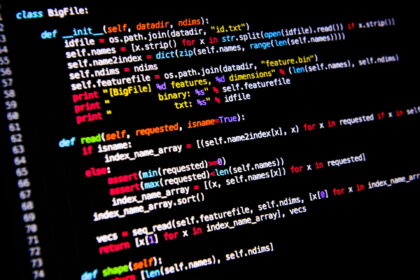EITC/CP/PPF Python Programming Fundamentals

EITC/CP/PPF Python Programming Fundamentals is the European IT Certification programme on the fundamentals of programming in Python language.
The curriculum of the EITC/CP/PPF Python Programming Fundamentals focuses on practical skills Python programming organized within the following structure, encompassing comprehensive video didactic content as a reference for this EITC Certification.
Python is an interpreted, high-level and general-purpose programming language. Python’s design philosophy emphasizes code readability with its notable use of significant whitespace. Its language constructs and object-oriented approach aim to help programmers write clear, logical code for small and large-scale projects. Python is often described as a “batteries included” language due to its comprehensive standard library. Python is commonly used in artificial intelligence projects and machine learning projects with the help of libraries like TensorFlow, Keras, Pytorch and Scikit-learn.
Python is dynamically-typed (executing at runtime many common programming behaviours that static programming languages perform during compilation) and garbage-collected (with automatic memory management). It supports multiple programming paradigms, including structured (particularly, procedural), object-oriented and functional programming. It was created in the late 1980s, and first released in 1991, by Guido van Rossum as a successor to the ABC programming language. Python 2.0, released in 2000, introduced new features, such as list comprehensions, and a garbage collection system with reference counting, and was discontinued with version 2.7 in 2020. Python 3.0, released in 2008, was a major revision of the language that is not completely backward-compatible and much Python 2 code does not run unmodified on Python 3. With Python 2’s end-of-life (and pip having dropped support in 2021), only Python 3.6.x and later are supported, with older versions still supporting e.g. Windows 7 (and old installers not restricted to 64-bit Windows).
Python interpreters are supported for mainstream operating systems and available for a few more (and in the past supported many more). A global community of programmers develops and maintains CPython, a free and open-source reference implementation. A non-profit organization, the Python Software Foundation, manages and directs resources for Python and CPython development.
As of January 2021, Python ranks third in TIOBE’s index of most popular programming languages, behind C and Java, having previously gained second place and their award for the most popularity gain for 2020. It was selected Programming Language of the Year in 2007, 2010, and 2018.
An empirical study found that scripting languages, such as Python, are more productive than conventional languages, such as C and Java, for programming problems involving string manipulation and search in a dictionary, and determined that memory consumption was often “better than Java and not much worse than C or C++”. Large organizations that use Python include i.a. Wikipedia, Google, Yahoo!, CERN, NASA, Facebook, Amazon, Instagram.
Beyond its artificial intelligence applications, Python, as a scripting language with modular architecture, simple syntax and rich text processing tools, is often used for natural language processing.
To acquaint yourself in-detail with the certification curriculum you can expand and analyze the table below.
The EITC/CP/PPF Python Programming Fundamentals Certification Curriculum references open-access didactic materials in a video form by Harrison Kinsley. Learning process is divided into a step-by-step structure (programmes -> lessons -> topics) covering relevant curriculum parts. Unlimited consultancy with domain experts are also provided.
For details on the Certification procedure check How it Works.
Curriculum Reference Resources
Python documentation
https://www.python.org/doc/
Python releases downloads
https://www.python.org/downloads/
Python for Beginners Guide
https://www.python.org/about/gettingstarted/
Python Wiki Beginners Guide
https://wiki.python.org/moin/BeginnersGuide
First steps
Functions Defined
The core of extensible programming is defining functions. Python allows mandatory and optional arguments, keyword arguments, and even arbitrary argument lists. More about defining functions in Python 3
# Python 3: Fibonacci series up to n
>>> def fib(n):
>>> a, b = 0, 1
>>> while a < n:
>>> print(a, end=' ')
>>> a, b = b, a+b
>>> print()
>>> fib(1000)
0 1 1 2 3 5 8 13 21 34 55 89 144 233 377 610 987Compound Data Types
Lists (known as arrays in other languages) are one of the compound data types that Python understands. Lists can be indexed, sliced and manipulated with other built-in functions. More about lists in Python 3
# Python 3: List comprehensions
>>> fruits = ['Banana', 'Apple', 'Lime']
>>> loud_fruits = [fruit.upper() for fruit in fruits]
>>> print(loud_fruits)
['BANANA', 'APPLE', 'LIME']
# List and the enumerate function
>>> list(enumerate(fruits))
[(0, 'Banana'), (1, 'Apple'), (2, 'Lime')]Intuitive Interpretation
Calculations are simple with Python, and expression syntax is straightforward: the operators +, -, * and / work as expected; parentheses () can be used for grouping. More about simple math functions in Python 3.
# Python 3: Simple arithmetic
>>> 1 / 2
0.5
>>> 2 ** 3
8
>>> 17 / 3 # classic division returns a float
5.666666666666667
>>> 17 // 3 # floor division
5Quick & Easy to Learn
Experienced programmers in any other language can pick up Python very quickly, and beginners find the clean syntax and indentation structure easy to learn. Whet your appetite with our Python 3 overview.
# Python 3: Simple output (with Unicode)
>>> print("Hello, I'm Python!")
Hello, I'm Python!
# Input, assignment
>>> name = input('What is your name?n')
>>> print('Hi, %s.' % name)
What is your name?
Python
Hi, Python.All the Flow You’d Expect
Python knows the usual control flow statements that other languages speak — if, for, while and range — with some of its own twists, of course. More control flow tools in Python 3
# For loop on a list
>>> numbers = [2, 4, 6, 8]
>>> product = 1
>>> for number in numbers:
... product = product * number
...
>>> print('The product is:', product)
The product is: 384
Download the complete offline self-learning preparatory materials for the EITC/CP/PPF Python Programming Fundamentals programme in a PDF file
EITC/CP/PPF preparatory materials – standard version
EITC/CP/PPF preparatory materials – extended version with review questions

